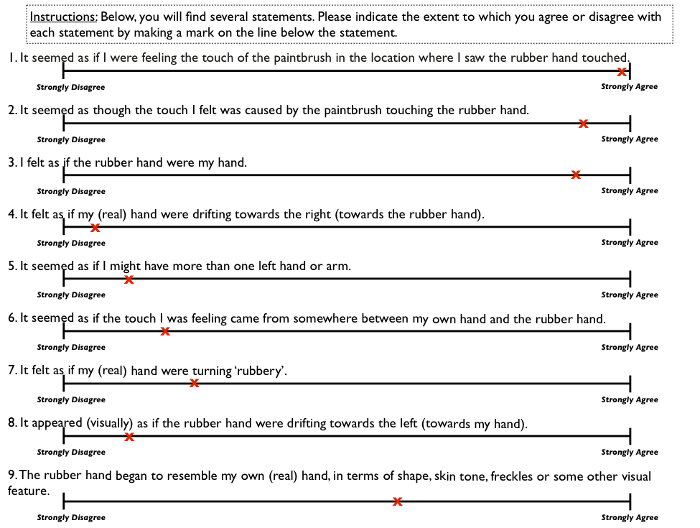ゴム手の幻想
概要
ソース: ジョナサン ・ Flombaum 講座-ジョンズ ・ ホプキンス大学
(床に落ちる) の代わりに座っている椅子の上に着陸の障害物を押すことがなく歩いてオブジェクトに手を伸ばし、これらは、私たちのすべての物理的な行動は、私たち自身の体を知って、私たちの手足と 1 つの別の基準と世界の残りの部分の空間を認識する能力に依存します。人間の脳はこの情報をエンコードする方法の 1 つは、固有感覚と呼ばれる、脳が手足を追跡する、独自のコントロールとフィードバック信号に依存しています。感覚入力と共に人間の脳は空間で体の部分を表すためにも音、タッチ、ビジョンを搭載します。方法はそれはこのすべての情報を結合するには?1998 年に Botvinick とコーエンは人間の脳が空間で体を表す感覚・固有感覚入力を統合する方法を調査するために使用されているゴムの手のイリュー ジョンと呼ばれる印象的な幻想を説明します。1このビデオはゴム手錯覚を誘発する方法を実演します、それは、その後の研究で使用されている方法を説明します。
手順
1. 材料
- この実験は、装置の 3 つの重要な部分を必要とする: ゴム手、2 つペイント ブラシ、遮蔽ボックス。
- 遮蔽ボックスを構築するには、約 1 フィート高いおよび 2 フィートの長さは、ボール紙が必要になります。真ん中に、直線を描画し、それぞれ 2 つの正方形の真ん中に手や腕を通過するのに十分な大きさのトンネルを切り取ります。図 1は、タスクの参加者の視点から見ると、ボックスのこの部分の図を示します。

図 1:の参加者の視点から見た遮蔽ボックスの図。ダン ボールの壁に 2 つの穴が大きいので参加者が快適に腕を挿入します。この図の拡大版を表示するのにはここをクリックしてください。
- 次に、段ボール箱の片側ボックスの 2 つの半分間の不透明な分周器と一緒に不透明なトップを添付します。参加者の本物の腕は、参加者から、視覚的に遮蔽ボックスのこの部分に移動します。図 2は、実験を行う者の観点から見ると、この添付ファイルを持つ完成したボックスの図を示します。

図 2:遮蔽ボックス実験者のビュー ポイントから見たの図。ダン ボールの壁に 2 つの穴が大きいので参加者が快適に腕を挿入します。不透明なトップとサイドは、参加者が挿入されます彼女の本物の腕、実験中にブラシを実験者を許可する側です。反対側は、ゴム腕が実験中に座る場所になります。この図の拡大版を表示するのにはここをクリックしてください。
- 最後に、参加者が錯覚する経験豊富な範囲を査定するために調査を行う必要があります。図 3 Botvinick とコーエンによって使用されるメソッドを直接モデルにして、このような調査であります。1

図 3:スケールの質問を調査。調査、実験終了後参加者が錯覚を経験する程度を評価するために使用されます。この図の拡大版を表示するのにはここをクリックしてください。
2. 錯覚を誘発します。
- 参加者の錯覚を誘発するには、遮蔽ボックスの平らな側面前のテーブルに彼女を座席します。挿入されるように彼女が彼女の左の腕快適穴彼女の左の肩から最も遠い、ボックスを配置する必要があります。
- 一度参加者が快適と挿入された彼女の腕に装着されている、参加者に近い穴から出るようにゴム腕を配置します。
- 彼女の左の腕と可能な限り少しの指を移動する参加者に指示します。
- オクルーダの壁に目を通す参加者を求めます。自分の腕は遮蔽ボックスのボックス部分の内部があるため表示できません。しかし、ゴム腕は彼女を完全に表示する必要があります。
- 今、参加者の前に座るし、彼女の本物の手とペイント ブラシとゴム手をゆっくりとブラシします。同期で磨いてみてください。10 分間ブラッシングを続けます。
- 参加者は、ゴムの手は、彼女自身のように感じる彼女の叫び声ブラッシングの期間の間に反応があります。このような経験、実験のコンテキストで通常知っている参加者をしましょう。
- 10 分後、ボックスとゴム腕を削除、アンケートに参加を求めます。
結果
図 4は、1 つの参加者の典型的な調査結果を示しています。最初の 3 つの項目で参加者はゴム手が彼女自身のように感じたこと、それは彼女がゴム手でブラッシングを感じることができたように感じたことは強く同意する傾向があります。そのゴムの視覚手 - 場所にどこ実際手べきである - 誘発した彼女の体の表現にゴム手を吸収する彼女の脳が示唆します。さらに、彼女はゴム手が明らかに接触受容体を持たないがブラッシングを経験しました。従ってこの文脈で、ブラッシングのビジュアル見てでブラッシングの感覚を生成する脳を誘導するために十分です。実際に触れることがなく、皮膚の少なくともいくつかの条件の下で効果タッチの重要な部分を感じることができるであります。視覚野は、私たちの体の感覚に驚くほど強力な役割を果たします。

図 4:典型的なアンケート回答します。
調査の残りの項目は、正反対が真実ではないことを示しています。人は、ゴム手の視覚的な表示が変わり始めたことを示すステートメントに同意する傾向があります。つまり、自分であることを感じてしていない、独自の外観のように見える。体の位置、タッチ、タッチ感ビジョンが重要な役割を果たしていると体の位置が同じようにビジョンを影響しません。
申請書と概要
ゴム手脳が複数の感覚システムからの情報を統合する方法の我々 の理解に重要な役割を再生し始めている奇妙な印象的な錯覚であります。Ehrsson と同僚 (2004 年) の重要な研究はたとえば、fMRI を同時に受けている参加者がここで説明したのとほぼ同じ方法でゴム手の錯覚を誘発しました。2比較のポイントは、研究者は、彼らを磨いたゴムとその参加者の実際の手非同期的に条件を使用されます。錯覚の経験は通常は発生しません。脳の活動にこの状態で脳の活動を比較すると、通常、同期描画状態の間に彼らでした。結果は、運動皮質の大きい活動を同期状態に生産だった。前野は、モーターの動作を制御するために使用する脳の部分です。活動は、誰かがアクションを実行する前に、この地域で発見通常。これは、運動前野は行動計画、いくつかの意味でのサイトなので自分の体の感覚の表現のメインのサイトでは結論に著者を導いた。その結果、体の異なるソースからの情報が統合になるサイトではまたです。
参考文献
- Botvinick, M., Cohen, J. Rubber hands 'feel' touch that eyes see. Nature. (1998).
- Ehrsson, H.H., Spence, C., Passingham, R.E. That's my hand! Activity in premotor cortex reflects feeling of ownership of a limb. Science. (2004).
タグ
スキップ先...
このコレクションのビデオ:

Now Playing
ゴム手の幻想
Sensation and Perception
18.6K 閲覧数

色の残像
Sensation and Perception
11.2K 閲覧数

あなたの盲点と知覚充填で検索
Sensation and Perception
17.4K 閲覧数

感覚と知覚の視点
Sensation and Perception
11.9K 閲覧数

運動誘発性の失明
Sensation and Perception
7.0K 閲覧数

エイムズの部屋
Sensation and Perception
17.5K 閲覧数

非注意性盲目
Sensation and Perception
13.4K 閲覧数

空間手がかり
Sensation and Perception
15.0K 閲覧数

注意の瞬き
Sensation and Perception
16.1K 閲覧数

混雑
Sensation and Perception
5.8K 閲覧数

倒立顔の効果
Sensation and Perception
15.7K 閲覧数

マガーク効果
Sensation and Perception
16.1K 閲覧数

ちょうど顕著な違い
Sensation and Perception
15.4K 閲覧数

知覚の限界を見つけるため階段のプロシージャ
Sensation and Perception
24.4K 閲覧数

オブジェクト置き換えマスキング
Sensation and Perception
6.6K 閲覧数
Copyright © 2023 MyJoVE Corporation. All rights reserved